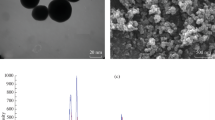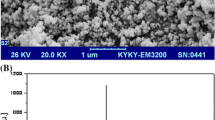Abstract
The iron nanoparticles with different physic-chemical properties induce inconsistent effects on various studied plant species. Thus, the effect of ferric oxide (Fe2O3) nanoparticles was compared with Fe2O3 microparticles and FeSO4complexes of EDTA for major physiological and gene expression in Rue (Ruta graveolens). Iron root content increased as Fe-MPs + EDTA ˂˂ Fe-NPs + EDTA˂ FeSO4 + EDTA. The shoot’s iron remained unchanged or slightly increased under most of FeSO4 and Fe-MPs + EDTA treatments. Under Fe-NPs + EDTA treatment, 50 and 250 µM concentration decreased on shoot iron by 23.2% and 19.4% compared to control, respectively. But the shoot iron at 500 µM NPs was 28.2% higher than that of the control. A 46–58 fold lower Fe translocation was observed under Fe-NPs + EDTA than Fe-MPs + EDTA. The effect of Fe-NPs + EDTA was more significant on plant fresh and dry mass than the control. All treatments showed an increase in anthocyanin by 19–84% in leaves compared to the control. The Fe-NPs + EDTA and MPs + EDTA induced similar effects on enhanced growth parameters, total chlorophyll, catalase enzyme activity, gene, and reduced chlorophyll a/b and oxidants. Catalase enzyme activity in FeSO4 and MPs + EDTA was similar, and in Fe-NPs + EDTA treatments were influenced by coarse and fine regulation mechanisms, respectively. Iron MPs + EDTA had a more negative effect on IRT1 relative gene expression in roots as compared to other iron forms. The IRT1 relative gene expression in shoots was positively affected by 31–81% under all treatment types (except control and 250 µM Fe-NPs + EDTA, and 250 µM MPs + EDTA). These results could reveal the potential mechanism of plant response to nanoparticles.
Key message
Fe2O3 nanoparticles with EDTA increased Fe bioavailability in rue plant but ameliorated metal toxicity. Fe2O3 nanoparticles induced dose-dependent and combined oxidative, growth and ion transporter promoting effects.





Similar content being viewed by others
Data availability
Enquiries about data availability should be directed to the authors.
References
Abogadallah GM, Serag MM, Quick WP (2010) Fine and coarse regulation of reactive oxygen species in the salt tolerant mutants of barnyard grass and their wild-type parents under salt stress. Physiol Plant 138(1):60–73
Asgarpanah J, Khoshkam R (2012) Phytochemistry and pharmacological properties of Ruta graveolens L. J Med Plant Res 6(23):3942–3949
Barrutia O, Garbisu C, Hernández-Allica J, García-Plazaola JI, Becerril JM (2010) Differences in EDTA-assisted metal phytoextraction between metallicolous and non-metallicolous accessions of Rumex acetosa L. Environ Pollut 158(5):1710–1715
Bombin S, LeFebvre M, Sherwood J, Xu Y, Bao Y, Ramonell K (2015) Developmental and reproductive effects of iron oxide nanoparticles in Arabidopsis thaliana. Int J Mol Sci 16(10):24174–24193
Bradford MM (1976) A rapid and sensitive method for the quantitation of microgram quantities of protein utilizing the principle of protein-dye binding. Anal Biochem 72(1):248–254
Caramanico L, Rustioni L, De Lorenzis G (2017) Iron deficiency stimulates anthocyanin accumulation in grapevine apical leaves. Plant Physiol Bioch 119:286–293
Chutipaijit S, Cha-um S, Sompornpailin K (2011) High contents of proline and anthocyanin increase protective response to salinity in 'Oryza sativa’ L. spp.‘indica.’ Aust J Crop Sci 5(10):1191–1198
Connolly EL, Fett JP, Guerinot ML (2002) Expression of the IRT1 metal transporter is controlled by metals at the levels of transcript and protein accumulation. Plant Cell 14(6):1347–1357
Gallego SM, Benavides MP, Tomaro ML (1996) Effect of heavy metal ion excess on sunflower leaves: evidence for involvement of oxidative stress. Plant Sci 121(2):151–159
Guo H, White JC, Wang Z, Xing B (2018) Nano-enabled fertilizers to control the release and use efficiency of nutrients. Curr Opin Environ Sci Health 6:77–83
Hall J, Williams LE (2003) Transition metal transporters in plants. J Exp Bot 54(393):2601–2613
Hothem SD, Marley KA, Larson RA (2003) Photochemistry in Hoagland’s nutrient solution. J Plant Nutr 26(4):845–854
Iannone MF, Groppa MD, de Sousa ME, van Raap MBF, Benavides MP (2016) Impact of magnetite iron oxide nanoparticles on wheat (Triticum aestivum L.) development: evaluation of oxidative damage. Environ Exp Bot 131:77–88
Jeevanandam J, Barhoum A, Chan YS, Dufresne A, Danquah MK (2018) Review on nanoparticles and nanostructured materials: history, sources, toxicity and regulations. Beilstein J Nanotechnol 9(1):1050–1074
Kalra Y (1997) Handbook of reference methods for plant analysis. CRC Press, Boca Raton
Krishnaswamy S, Spitzer MH, Mingueneau M, Bendall SC, Litvin O, Stone E, Pe’er D, Nolan GP (2014) Conditional density-based analysis of T cell signaling in single-cell data. Science 346(6213):1250689
Libralato G, Devoti AC, Zanella M, Sabbioni E, Mičetić I, Manodori L, Pigozzo A, Manenti S, Groppi F, Ghirardini AV (2016) Phytotoxicity of ionic, micro-and nano-sized iron in three plant species. Ecotoxicol Environ Saf 123:81–88
Lichtenthaler HK, Buschmann C (2001) Chlorophylls and carotenoids: measurement and characterization by UV-VIS spectroscopy. Curr Protoc Food Anal Chem 1(1):F4.3.1-F4.3.8
Lin D, Xing B (2008) Root uptake and phytotoxicity of ZnO nanoparticles. Environ Sci Technol 42(15):5580–5585
Liu R, Zhang H, Lal R (2016) Effects of stabilized nanoparticles of copper, zinc, manganese, and iron oxides in low concentrations on lettuce (Lactuca sativa) seed germination: nanotoxicants or nanonutrients? Water Air Soil Pollut 227(1):42
Lv J, Christie P, Zhang S (2019) Uptake, translocation, and transformation of metal-based nanoparticles in plants: recent advances and methodological challenges. Environ Sci Nano 6(1):41–59
Malik S, Moraes DFC, do Amaral FMM, Ribeiro MNS (2017) Ruta graveolens: phytochemistry, pharmacology, and biotechnology. Transgenesis Second Metab 4:177–204
Mazaheri-Tirani M, Dayani S (2019) In vitro effect of zinc oxide nanoparticles on Nicotiana tabacum callus compared to ZnO micro particles and zinc sulfate (ZnSO4). Plant Cell Tissue Organ Cult. https://doi.org/10.1007/s11240-019-01725-0
Meers E, Ruttens A, Hopgood M, Samson D, Tack F (2005) Comparison of EDTA and EDDS as potential soil amendments for enhanced phytoextraction of heavy metals. Chemosphere 58(8):1011–1022
Michael PI, Krishnaswamy M (2014) Membrane damage and activity of antioxidant enzymes in response to zinc and high irradiance stress in cowpea plant. Int J Curr Res 2(10):112–128
Mirecki N, Agic R, Sunic L, Milenkovic L, Ilic S (2015) Transfer factor as indicator of heavy metals content in plants. Fresenius Environ Bull 24(11c):4212–4219
Nourozi E, Hosseini B, Maleki R, Abdollahi Mandoulakani B (2019) Iron oxide nanoparticles: a novel elicitor to enhance anticancer flavonoid production and gene expression in Dracocephalum kotschyi hairy-root cultures. J Sci Food Agric 99(14):6418–6430
Palmer CM, Guerinot ML (2009) Facing the challenges of Cu, Fe and Zn homeostasis in plants. Nat Chem Biol 5(5):333
Pavić V, Flačer D, Jakovljević M, Molnar M, Jokić S (2019) Assessment of total phenolic content, in vitro antioxidant and antibacterial activity of Ruta graveolens L. extracts obtained by choline chloride based natural deep eutectic solvents. Plants 8(3):69
Pfaffl MW, Horgan GW, Dempfle L (2002) Relative expression software tool (REST©) for group-wise comparison and statistical analysis of relative expression results in real-time PCR. Nucleic Acids Res 30(9):e36–e36
Ramakers C, Ruijter JM, Deprez RHL, Moorman AF (2003) Assumption-free analysis of quantitative real-time polymerase chain reaction (PCR) data. Neurosci Lett 339(1):62–66
Rui M, Ma C, Hao Y, Guo J, Rui Y, Tang X, Zhao Q, Fan X, Zhang Z, Hou T (2016) Iron oxide nanoparticles as a potential iron fertilizer for peanut (Arachis hypogaea). Front Plant Sci 7:815
Sánchez-Alcalá I, Del Campillo M, Torrent J (2014) Extraction with 0.01 M CaCl2 underestimates the concentration of phosphorus in the soil solution. Soil Use Manage 30(2):297–302
Sheykhbaglou R, Sedghi M, Shishevan MT, Sharifi RS (2010) Effects of nano-iron oxide particles on agronomic traits of soybean. Notulae Sci Biol 2(2):112–113
Shi P, Song C, Chen H, Duan B, Zhang Z, Meng J (2018) Foliar applications of iron promote flavonoids accumulation in grape berry of Vitis vinifera cv. merlot grown in the iron deficiency soil. Food Chem 253:164–170
Souri MK, Hatamian M (2019) Aminochelates in plant nutrition: a review. J Plant Nutr 42(1):67–78
Tirani M, Haghjou M (2019) Reactive oxygen species (ROS), total antioxidant capacity (AOC) and malondialdehyde (MDA) make a triangle in evaluation of zinc stress extension. J Anim Plant Sci 29(4):1100–1111
Tripathy BC, Oelmüller R (2012) Reactive oxygen species generation and signaling in plants. Plant Signal Behav 7(12):1621–1633
Van Nhan L, Ma C, Rui Y, Cao W, Deng Y, Liu L, Xing B (2016) The effects of Fe2O3 nanoparticles on physiology and insecticide activity in non-transgenic and Bt-transgenic cotton. Front Plant Sci 6:1263
Varotto C, Maiwald D, Pesaresi P, Jahns P, Salamini F, Leister D (2002) The metal ion transporter IRT1 is necessary for iron homeostasis and efficient photosynthesis in Arabidopsis thaliana. Plant J 31(5):589–599
Wagner GJ (1979) Content and vacuole/extravacuole distribution of neutral sugars, free amino acids, and anthocyanin in protoplasts. Plant Physiol 64(1):88–93
Wang H, Kou X, Pei Z, Xiao JQ, Shan X, Xing B (2011) Physiological effects of magnetite (Fe3O4) nanoparticles on perennial ryegrass (Lolium perenne L.) and pumpkin (Cucurbita mixta) plants. Nanotoxicology 5(1):30–42
Wang Y-x, Hu Y, Zhu Y-f, Baloch AW, Jia X-m, Guo A-x (2018) Transcriptional and physiological analyses of short-term Iron deficiency response in apple seedlings provide insight into the regulation involved in photosynthesis. BMC Genomics 19(1):461
Wang Y, Wang S, Xu M, Xiao L, Dai Z, Li J (2019) The impacts of γ-Fe2O3 and Fe3O4 nanoparticles on the physiology and fruit quality of muskmelon (Cucumis melo) plants. Environ Pollut 249:1011–1018
Wegner A, Meiser J, Weindl D, Hiller K (2015) How metabolites modulate metabolic flux. Curr Opin Biotechnol 34:16–22
Wojcieszek J, Jiménez-Lamana J, Ruzik L, Szpunar J, Jarosz M (2020) To-do and not-to-do in model studies of the uptake, fate and metabolism of metal-containing nanoparticles in plants. Nanomaterials 10(8):1480
Yang J, Cao W, Rui Y (2017) Interactions between nanoparticles and plants: phytotoxicity and defense mechanisms. J Plant Interact 12(1):158–169
Yousefzadeh S, Sabaghnia N (2016) Nano-iron fertilizer effects on some plant traits of dragonhead (Dracocephalum moldavica L.) under different sowing densities. Acta Agric Slov 107(2):429–437
Zhang X, Zhang D, Sun W, Wang T (2019) The adaptive mechanism of plants to iron deficiency via iron uptake, transport, and homeostasis. Int J Mol Sci 20(10):2424
Zuverza-Mena N, Martínez-Fernández D, Du W, Hernandez-Viezcas JA, Bonilla-Bird N, López-Moreno ML, Komárek M, Peralta-Videa JR, Gardea-Torresdey JL (2017) Exposure of engineered nanomaterials to plants: Insights into the physiological and biochemical responses—a review. Plant Physiol Biochem 110:236–264
Funding
The authors have not disclosed any funding.
Author information
Authors and Affiliations
Contributions
MM-T designed the research and supervised the experiments and analyzed physiology data and drafted the manuscript. AK performed experiments. MKD supervised the experiments and analyzed molecular data.
Corresponding author
Ethics declarations
Conflict of interest
The authors declare that they have no conflict of interests.
Additional information
Publisher’s Note
Springer Nature remains neutral with regard to jurisdictional claims in published maps and institutional affiliations.
Supplementary Information
Below is the link to the electronic supplementary material.
Rights and permissions
About this article
Cite this article
Mazaheri-Tirani, M., Kashani, A. & Koohi-Dehkordi, M. The role of iron nanoparticles on morpho-physiological traits and genes expression (IRT1 and CAT) in rue (Ruta graveolens). Plant Mol Biol 110, 147–160 (2022). https://doi.org/10.1007/s11103-022-01292-7
Received:
Accepted:
Published:
Issue Date:
DOI: https://doi.org/10.1007/s11103-022-01292-7




